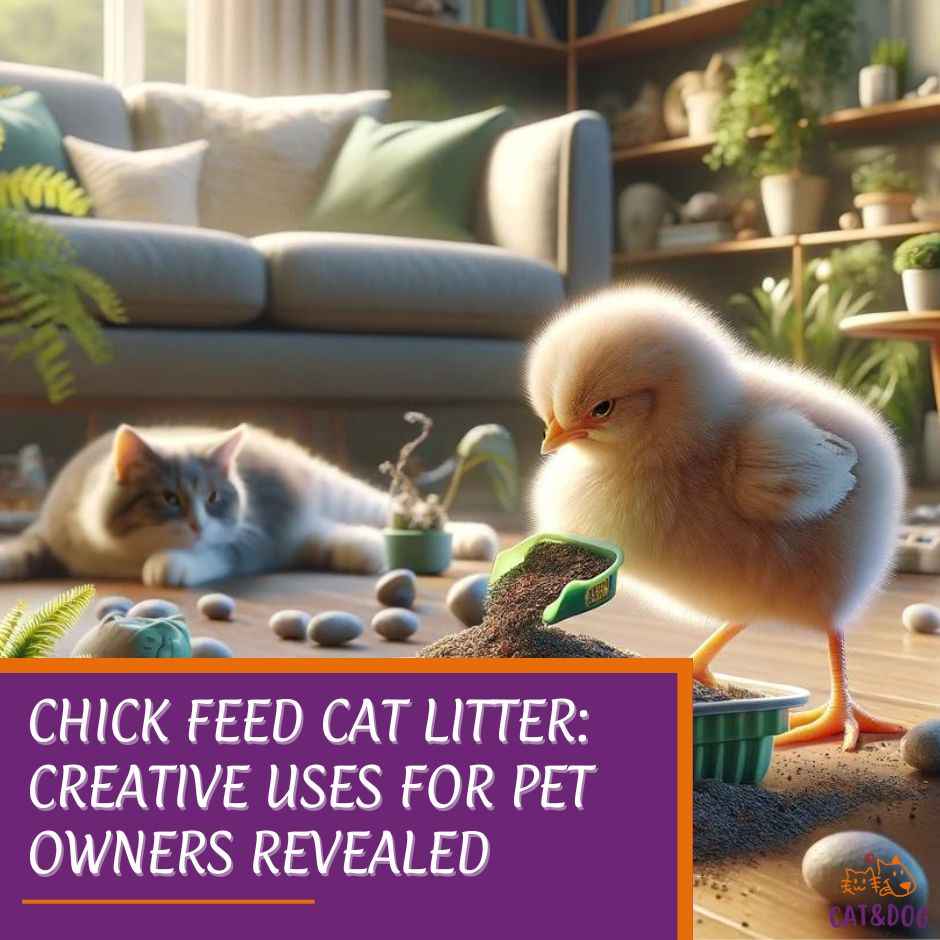Have you ever thought about what goes in your cat’s litter box and wondered if there’s a more sustainable option? Well, chick feed cat litter may just be the answer you’re looking for!
For pet owners seeking eco-friendly alternatives, incorporating natural cat litter into their sustainable living practices offers an innovative approach to cat care, aligning with the benefits of using chick feed as a litter solution.
It’s been gaining traction among cat owners as a cost-effective and environmentally friendly option.
If you’re intrigued by unconventional solutions and love to do what’s best for your furry friend and the planet, let’s get into the ‘grainy’ details of what it could mean to use chicken feed as cat litter.

You might be asking, “Is it really okay for my cat?” or “How does it stack up against traditional litters?” These are valid concerns.
After all, your cat’s health and comfort, along with the maintenance of your home, are top priorities.
Chicken feed, typically a blend of grains like corn, wheat, and soybean, plus vitamins and minerals, is not formulated with litter boxes in mind, but some pet owners have found it to be a compelling alternative. (1)
It’s about weighing the pros and cons, from its affordability to its ease of use, clumping properties, and how it compares to your cat’s usual litter.
To enhance the odor control effectiveness of chick feed cat litter, exploring natural odor control solutions like mixing in baking soda or using activated charcoal can significantly improve the freshness of your cat’s litter box
Key Takeaways
- Chicken feed is an eco-friendly and affordable cat litter alternative.
- It’s important to consider your cat’s health and the product’s ease of maintenance.
- Assessing the overall benefits and drawbacks helps determine its suitability for your home.
Chick Feed Cat Litter: Safety and Health Considerations
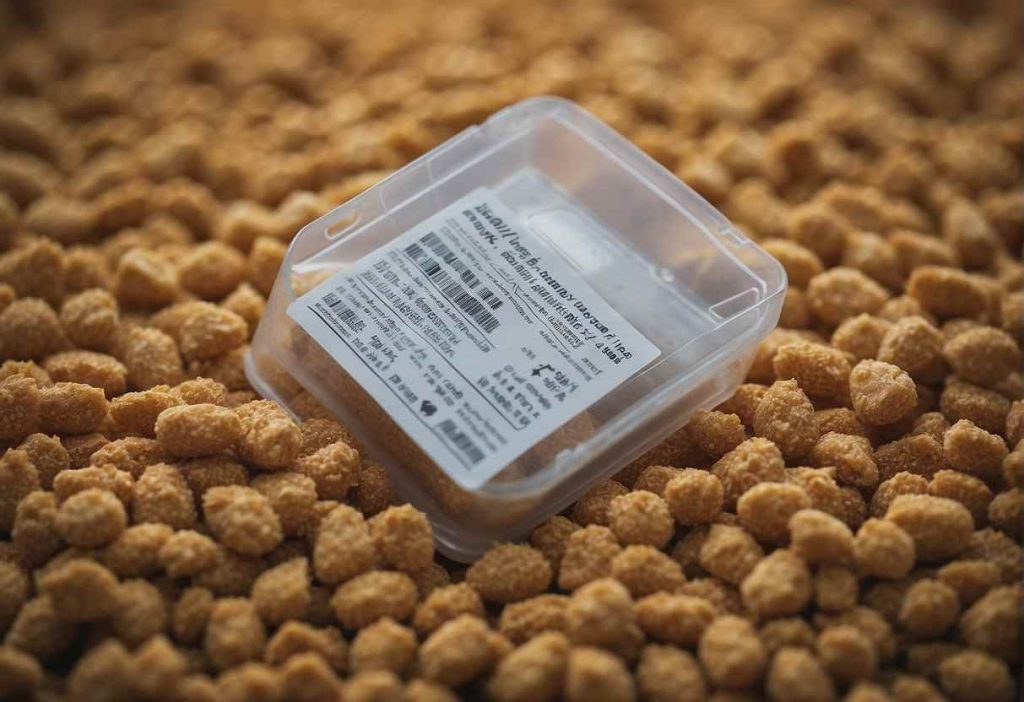
Chicken feed isn’t designed for cats, and using it for litter comes with its own set of concerns.
Ingestion Risks and Respiratory Issues:
- Bacteria: Chicken feed may harbor bacteria like salmonella or E. coli. These can be especially harmful if your furry friend ingests particles while grooming. (2)
- Dustiness: Some chicken feeds are quite dusty, which could lead to respiratory issues for both you and your cat. (3)
Expert Opinions on Safety:
- Vet Insights: Always consult with a vet before making a switch. They know your cat’s health history and can give you tailored advice.
- Pellet Form: If your vet gives the all-clear, opt for pellet form chicken feed and consider adding baking soda to manage odors effectively.
Practical Tips:
- Attracting Pests: The scent might draw in unwanted guests like rodents or bugs, so keep an eye on that.
- Absorbency: Check the absorbency level since cat urine can quickly turn into a stinky situation.
- Additives: Be wary of any chemicals or additives in the feed that aren’t feline-friendly.
For those concerned about air quality and respiratory health, selecting chick feed cat litter formulated as low dust formulas can significantly reduce airborne particles, making it a safer choice for both pets and their owners.
When choosing chicken feed for your cat’s litter, think about the potential health risks. A well-informed decision can help keep your feline companion both happy and healthy.
Remember, what’s best for chickens might not be the cat’s meow for your cat!
Practical Use and Maintenance
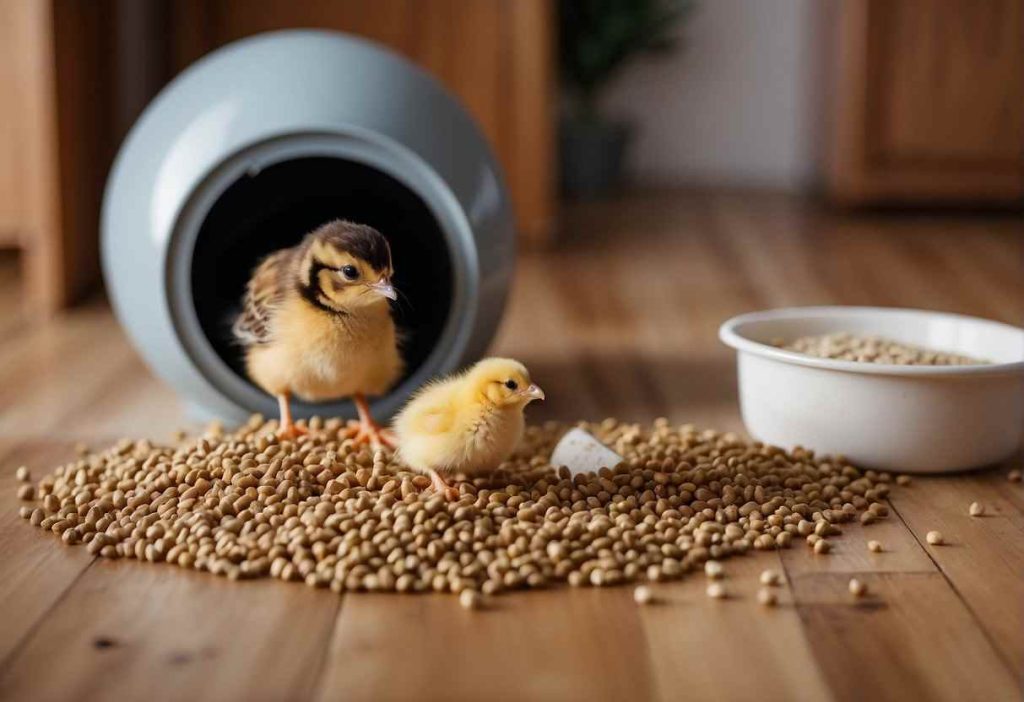
Transitioning Your Cat to Chicken Feed Litter
Did you know cats can be pretty finicky about their bathrooms? Here’s a quick guide to help ease the transition:
- Mix it up: Start by mixing chicken feed with your regular litter.
- Increase Gradually: Slowly increase the amount of chicken feed over time.
- Keep it Familiar: Maintain the usual cleaning schedule to not throw off your cat’s routine.
Maintaining a Clean and Odor-Free Litter Box
Wondering how to combat that pesky odor?
- Scoop Daily: Ensure to remove waste every day to prevent smells.
- Change Regularly: Replace the chicken feed litter completely every week.
- Dry Base: Keep the litter box in a dry place as chicken feed is highly absorbent and may clump if wet.
Selecting the Right Chicken Feed
Let’s talk about picking the perfect feed for litter purposes:
- Absorbency: You’ll want a highly absorbent feed.
- Dust factor: Opt for low-dust options to keep it breathable.
- Non-toxic: Ensure it’s free from additives that might harm your cat.
Remember, while chicken feed can be an economical substitute for cat litter, it’s crucial to choose a type that ensures your cat’s health and comfort.
Keep these tips in mind for a smooth litter box experience!
Cost-Effectiveness Analysis
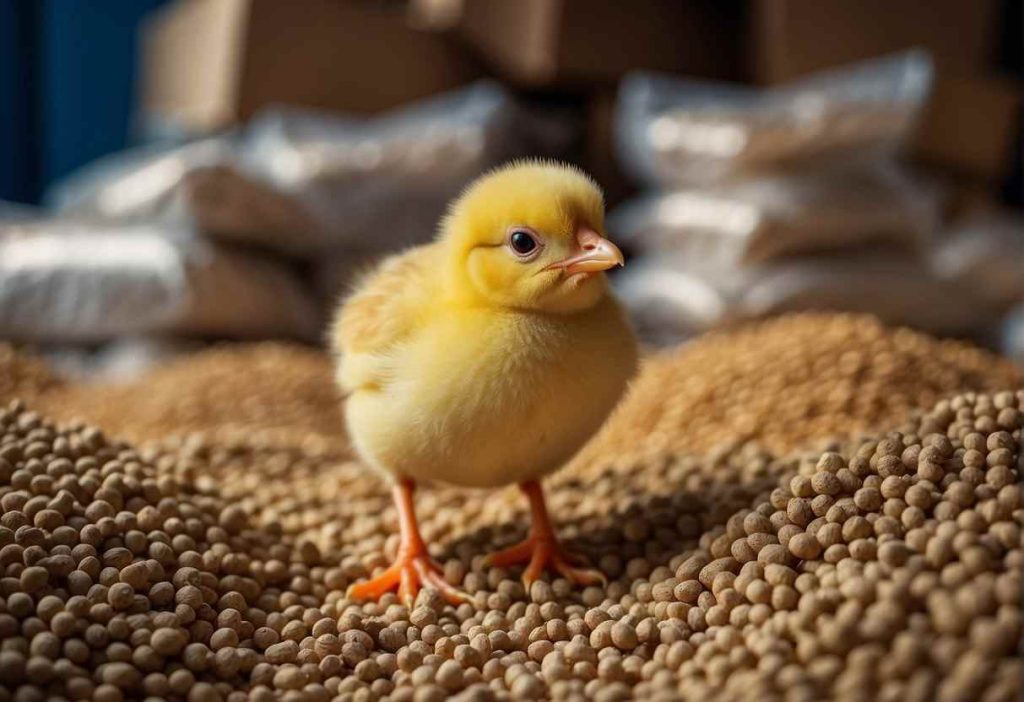
Traditional clay-based cat litter might dig a bigger hole in your wallet than you’d wish.
Think about it: a bag of standard litter can cost anywhere from $5 to $15 depending on the brand and type, which over the months, really adds up.
Now, let’s talk chicken feed—yep, the stuff for the birds!
Surprisingly, a 50-pound bag of chicken feed can range from $10 to $20, lasting you longer because of its bulk nature. Here’s a fun comparison:
| Cat Litter Type | Cost per Month | Bulk Purchase |
| Traditional Cat Litter | $15-$45 | 20 lbs |
| Chicken Feed | $5-$10 | 50 lbs |
See the difference? Your furry friend might not know it’s saving you money, but your wallet will feel the relief.
Think long-term too. Over a year, the savings from switching to chicken feed litter can be substantial:
- Traditional Cat Litter: $180 to $540
- Chicken Feed: $60 to $120
How about extra savings in your pocket for treats and toys—or maybe a fancy new scratching post?
Remember to store chicken feed properly to avoid weevils, and no, it’s not a pizza topping, so best not to flush it down the toilet, okay?
A little baking soda mixed in, and voila—odor managed! (4)
So, why not give chicken feed a shot as a litter box contender? Your cat won’t judge you for being savvy with your cents!
Environmental Impact and Sustainability
Eco-Friendly Benefits of Chicken Feed Litter
- Biodegradability: Unlike traditional clay-based litters that sit in landfills, chicken feed is biodegradable. This means it breaks down naturally over time, reducing your cat’s environmental clawprint.
- Sustainable Sourcing: Chicken feed is often composed of natural grains, which means it’s a renewable resource. Opting for chicken feed litter can contribute to a more sustainable cycle of production and disposal. (5)
Comparative Environmental Impact
When you’re weighing chicken feed against traditional cat litters, consider this:
| Feature | Chicken Feed Litter | Traditional Cat Litter |
| Biodegradability | High | Low to Moderate |
| Renewable Source | Yes | No (for clay and silica) |
| Manufacturing Energy | Lower | Higher |
Remember, traditional litters often come from clay or silica that requires significant energy to mine and process.
On the flip side, chicken feed is a by-product of agriculture, already in production for other purposes.
Environmental Pros and Cons
Are there any downsides? You bet! While chicken feed can be a sustainable option, it’s essential to be mindful of potential contamination. Some chicken feeds may contain harmful bacteria or additives.
Always ensure the feed you choose is safe and chemical-free to keep your feline friend healthy. By choosing wisely, you can make a positive impact!
Your furry friend’s litter box could contribute to a healthier planet. Isn’t it amazing to think that your cat could be a tiny, purring eco-warrior?
Pros and Cons of Chicken Feed as Cat Litter

Advantages for Pet Owners
Cost-Effectiveness: Your wallet can breathe a sigh of relief!
Chicken feed is notably less pricey than traditional cat litter, so it’s kind on your budget.
Environmental Friendliness: Made from natural materials, chicken feed is biodegradable.
If you’re green at heart, this might be a big win for you and Mother Earth!
Absorbency: Like a sponge, chicken feed soaks up moisture effectively.
Which means it might just handle heavy-duty bathroom breaks like a champ.
Potential Drawbacks and Solutions
Dust and Allergies: Chicken feed can be a dusty affair, posing allergy issues for both you and your furball.
- Solution: Opt for pelletized chicken feed or spritz a bit of water to weigh down the dust.
Texture and Smell Sensitivities: Some sophisticated feline noses may turn up at the scent or texture.
- Strategy: Gradually introduce chicken feed by mixing it with their usual litter, giving your cat time to acclimate to their new, budget-friendly throne.
Pairing your sustainable chick feed cat litter with eco-friendly litter bags not only enhances your commitment to an environmentally conscious lifestyle but also ensures that every aspect of your cat care routine contributes positively to reducing your carbon pawprint.
Remember, every cat is unique, so one kitty’s dream litter could be another’s nightmare.
Your furry overlord’s approval is the ultimate seal of success! Keep an open mind, try to mitigate the drawbacks and who knows, chicken feed could just be the next best thing in your litter box adventures.
Real-life Experiences and Case Studies
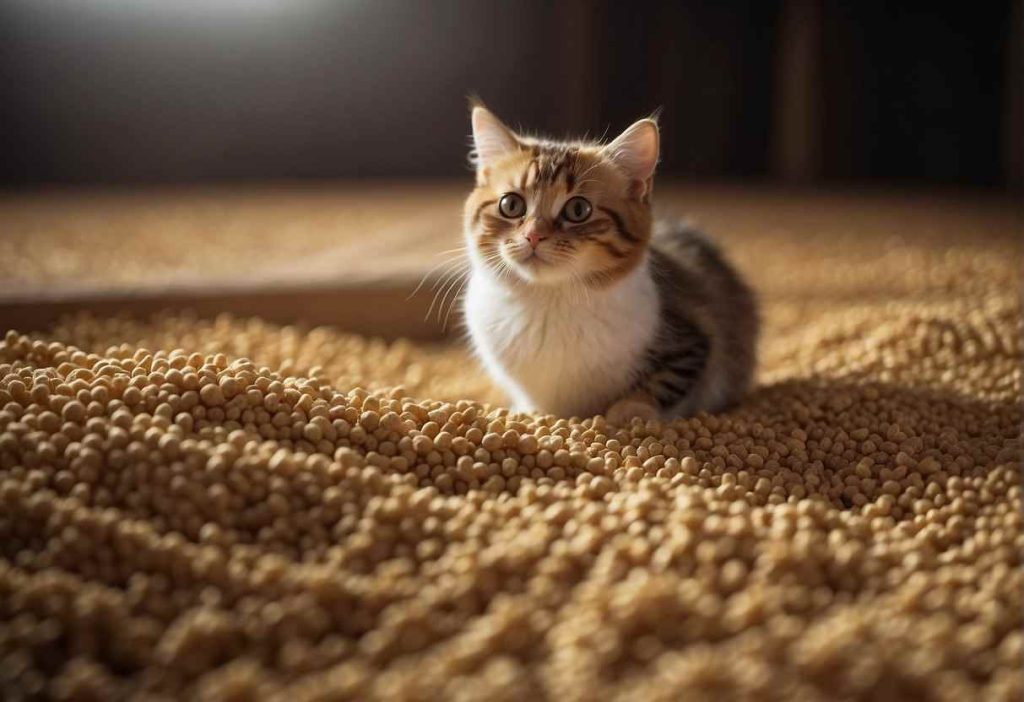
Success Stories from Cat Owners
Many have found chicken feed to be an economical solution. There’s chatter about reduced costs while keeping the kitties’ content.
- Testimonial 1: “I switched to chicken feed, and it’s been great for my wallet and my cat loves it!”
- Testimonial 2: “The natural smell is a game changer – no more artificial fragrances.”
Challenges and How to Overcome Them
Sure, it’s not all purrs and cuddles.
The feed can get messy, and if your cat’s a picky patron of the litter box, they might turn their nose up at the texture.
It doesn’t clump as conventional litter and might invite weevils if not stored properly.
User Solutions:
- Store in airtight containers to beat the weevil blues.
- Invest in a high-sided litter box to keep those spills at bay.
Detailed User Experiences
Remember Rosalind from Backyard Chickens? She recounts a lady loading up on poultry feed for her feline friends.
It’s proof that this unconventional litter choice is sparking interest—and debate!
Cats’ Reactions:
- Preferences vary; some cats adapt, and others need coaxing with a gradual mix-in method.
Using chicken feed as cat litter isn’t just hearsay—it’s a practice that everyday cat lovers like you are trying out.
It might take some tweaking, but could you be the next to join the chicken feed litter league?
Expert Insights and Recommendations

Veterinary Advice on Chicken Feed Litter
Curious about swapping traditional litter for chicken feed? Let’s talk about the veterinary perspective.
Vets urge caution with this alternative due to the potential for pests and allergens. However, they don’t rule it out if you:
- Choose high-quality, pellet-form chicken feed to minimize dust.
- Monitor your cat for any allergic reactions. (6)
- Make sure to store feed in a cool, dry place to prevent weevil infestation.
Professional recommendations for safe use include:
- Mix in baking soda to control odors effectively.
- Regularly clean the litter box to keep it pest-free.
- Stay aware of your cat’s behavior and health for any changes.
Tips from Experienced Pet Owners
Heard from the cat’s meow? Seasoned pet owners who’ve embraced chicken feed litter share practical nuggets of wisdom:
- Cost-effectiveness: It’s a wallet-friendly option compared to many commercial litters.
- Absorbency: Like a sponge, this stuff can soak up quite a bit! But clumping? Not its strongest suit.
- Disposal: Don’t flush! Composting or trash is the way to go. (7)
Here’s how to set up shop with chicken feed litter:
- Begin by mixing it with your current litter, gradually increasing the chicken feed proportion.
- Observe your cat’s acceptance – some might give you a cold tail at first.
Remember, each cat is a unique feline being.
While chicken feed as cat litter can work, it’s essential to weigh the pros and cons, noting that it isn’t a one-size-fits-all solution.
Got your notepad? Keep tabs on these points. If you decide to try chicken feed litter, your whiskered friend’s comfort and health should always be the top priority.
Alternative Eco-Friendly Cat Litter Options

Let’s pounce on some sustainable options that are not only better for the planet but also for your fluffy friend.
Paper Pellets: You might have read the headlines, but did you realize that the news can also be under the paws of your feline?
Recycled paper litter, such as Fresh News, is a fabulous choice.
It’s absorbent and often recommended by vets. Plus, who doesn’t love upcycling?
- Pros: Highly absorbent, low tracking
- Cons: May need frequent changing
Wood Shavings: Splinter-free and smelling like a forest, wood-based litters like Ökocat Natural Wood Cat Litter bring a bit of nature to your cat’s litter box.
This option boasts a fresh scent without artificial additives.
- Pros: Natural odor control, biodegradable
- Cons: Might not clump as well as clay litters
Wheat: Now, here’s a grain of truth for you—wheat litter can be a game-changer. Ground wheat berries are naturally clumping and easy to scoop, making clean-up a breeze.
- Pros: Clumping action, compostable
- Cons: Could attract bugs if not stored properly
Coconut Litter: Sounds exotic, right?
Coconut husk litter is a newcomer on the block, known for its lightness and odor-fighting properties.
Your cat’s litter might just transport you to a tropical paradise!
- Pros: Lightweight, good for odor control
- Cons: May be less readily available
How to Choose the Best Option for Your Cat
- Comfort: Does your cat prefer a certain texture? Some felines are fussy about their paws.
- Health: Any allergies or post-surgical needs?
- Maintenance: Are you okay with more frequent changes or do you prefer a low-maintenance litter?
- Environment: Prioritize biodegradable or compostable materials if you’re eco-minded.
You can check other cat litter recommendations here if some of the alternatives we have provided above don’t suit what you want.
Remember, every cat is unique, so it might take some trial and error before you both find the purr-fect match. Keep it green, keep it clean, and enjoy those extra cuddles knowing you’re making a difference!
Quick Recap
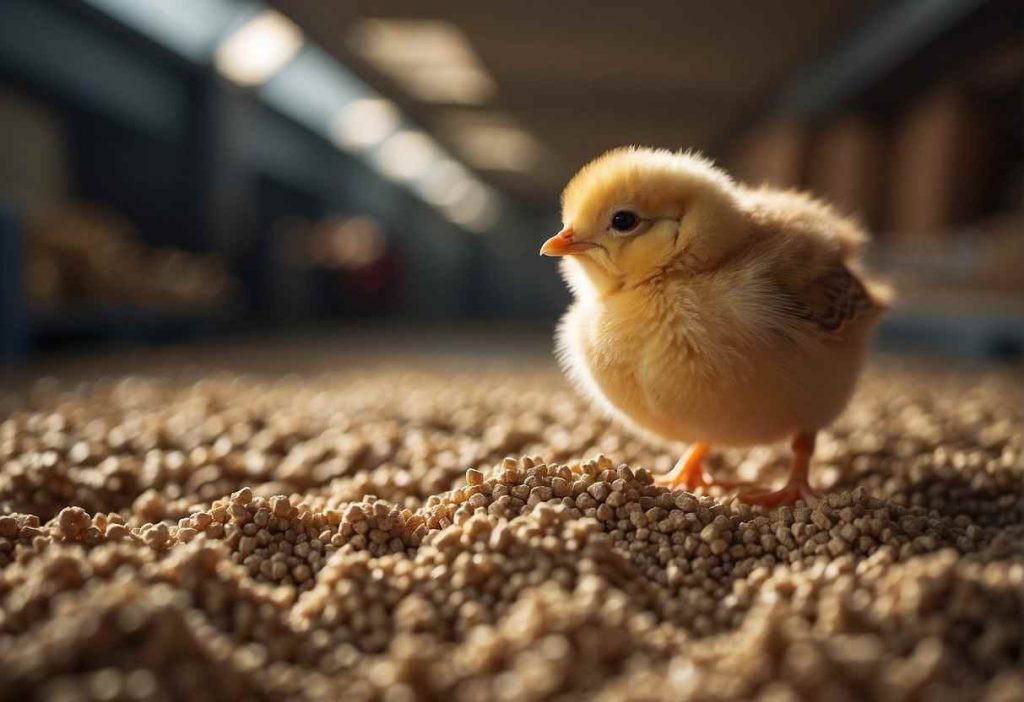
Curious about what’s clucking in the litter box? Here’s the pecking order of what you need to know:
- Messiness: Chicken feed wasn’t engineered for feline business, so brace yourself for potential spillage outside the box.
- Texture Issues: Your kitty might turn up its nose at the texture. Comfort is king for cats, after all.
Storage & Weevils:
- Store it right to prevent little weevil party-crashers.
- A cool, dry place is your storage sweet spot.
Allergies & Dust:
- Some cats might be allergic. A quick vet chat beforehand could save sneezes.
- It could be dusty—watch out if you’re furball or you have sensitive lungs.
Clumping & Flushability:
- Does it clump? It’s a mix—some do, some don’t.
- Flushing? Only if you want to gamble with your plumbing.
Comparison to Other Litters:
- How does it stack up to the World’s Best Cat Litter (WBCL)? That’s a scratch on specifics, but each has its pros and cons.
Remember, not all feeds are created equal, so check those labels! And while we’re talking chicken, there’s a peep in the industry about eco-friendly alternatives popping up.
Something to keep an eye on for your green paws out there. Now, armed with the facts, you’re set to make a choice that’s best for your purring pal and your peace of mind.
Frequently Asked Questions
Choosing an alternative cat litter like chicken feed can be loaded with benefits, but it’s natural to have some questions before making the switch.
Let’s tackle some common inquiries to ensure your cat’s litter solution is both safe and satisfying.
Is chicken feed safe to use as cat litter for all cats, including kittens?
Most chicken feed is generally safe for adult cats. However, for kittens, it’s crucial to ensure the product is non-toxic and does not pose a choking hazard.
Always consult with a veterinarian before introducing any new litter to your feline’s routine. This is especially important for young or health-compromised cats.
How can I transition my cat to using chicken feed as litter without causing stress?
Transitioning to chicken feed as litter should be a gradual process.
Start by mixing a small amount of chicken feed with your cat’s current litter and slowly increase the proportion over time.
This lets your cat adjust to the new texture and scent without stress.
What are the cost benefits of using chicken feed compared to traditional cat litter?
Chicken feed is often less expensive than commercial cat litter and comes in larger quantities.
By opting for chicken feed, you could see significant savings over time. However, this depends on local prices and your cat’s litter usage.
Can chicken feed as cat litter help reduce my environmental footprint?
Yes, using chicken feed as cat litter can be more sustainable, especially if you opt for organic and biodegradable options.
It’s a practical way to lower waste, as chicken feed can potentially be composted and doesn’t rely on the mining of clay, which is common in traditional litter.
What should I do if my cat ingests chicken feed used as litter?
While chicken feed is not designed for ingestion, small amounts should not harm your cat.
However, if you notice your cat eating the litter, it’s best to switch to a non-toxic, pet-safe alternative and consult your veterinarian.
How do I manage dust and maintain a clean environment when using chicken feed as cat litter?
Choose a low-dust chicken feed formula and keep the litter box in a well-ventilated area.
Clean the box regularly and consider using a litter mat to minimize tracking and maintain cleanliness around the litter area.
Are there any health risks associated with using chicken feed as cat litter?
Dust from chicken feed may cause respiratory issues for both you and your cat. Monitor for any allergic reactions, and always opt for dust-free or low-dust options.
Regular cleaning and proper storage can also help mitigate any potential health risks.

